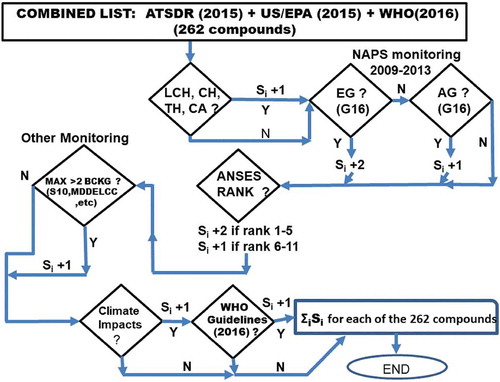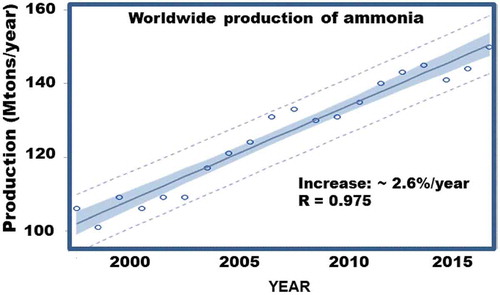Figures & data
Table 1. List of emerging air pollutants selected using the methodology shown in (gas and metals) or from literature (particles). Legend: CA: carcinogenic in animals, CH: carcinogenic in humans, TH: toxic in humans, MH: mutagenic in humans, LCH: likely carcinogenic in humans; EG: exceeding one or more provincial guidelines at least at one or more observing sites (G16; Galarneau et al. Citation2016), AG: approaching guidelines at least at one or more observing sites (G16); MIR: maximum weighted incremental reactivity (see definition in Supplementary material S1). ECCC: Environment and climate change Canada; rank: based on a score risk for health (ANSES Citation2018). UFPs: ultrafine particles, eNPs: engineered nanoparticles, WHO: World Health Organization, CASRN: Chemical abstract service registry number.
Table 2. Results of the prioritization algorithm (from ): a proposed selection of the most critical emerging outdoor pollutant.
Table 3. A) Top 10 highest average concentration during summer at the site under the plume of Montreal (based on ESOM-96 campaign), B) Top 10 highest percentage weighted MIR (Maximum Incremental Reactivity) percentage at a site under the plume of Montreal.
Figure 1. Algorithm used to select emerging pollutants. ATSDR: Agency for toxic substances and disease registry. WHO: World health organization. MDDELCC: Ministère du Développement Durable, de l’Environnement et de la Lutte contre les Changements Climatiques, Québec. ANSES: Agence Nationale de Sécurité Sanitaire, Alimentation, Environnement, Travail (France). LCH: likely carcinogenic to human, CH: carcinogenic to human. TH: toxic or reprotoxic, CA: carcinogenic in animal, BGCK: background value (see definition in S1), EG: exceeding provincial guidelines, AG: approaching guidelines (within an order of magnitude), S10: Simpson et al. (Citation2010).

Figure 2. Worldwide production of ammonia (1998–2017). Raw data obtained from. Raw data obtained from https://www.usgs.gov/centers/nmic/mineral-commodity-summaries

Table 4. Selected provincial guidelines with a factor of variability across provinces.
